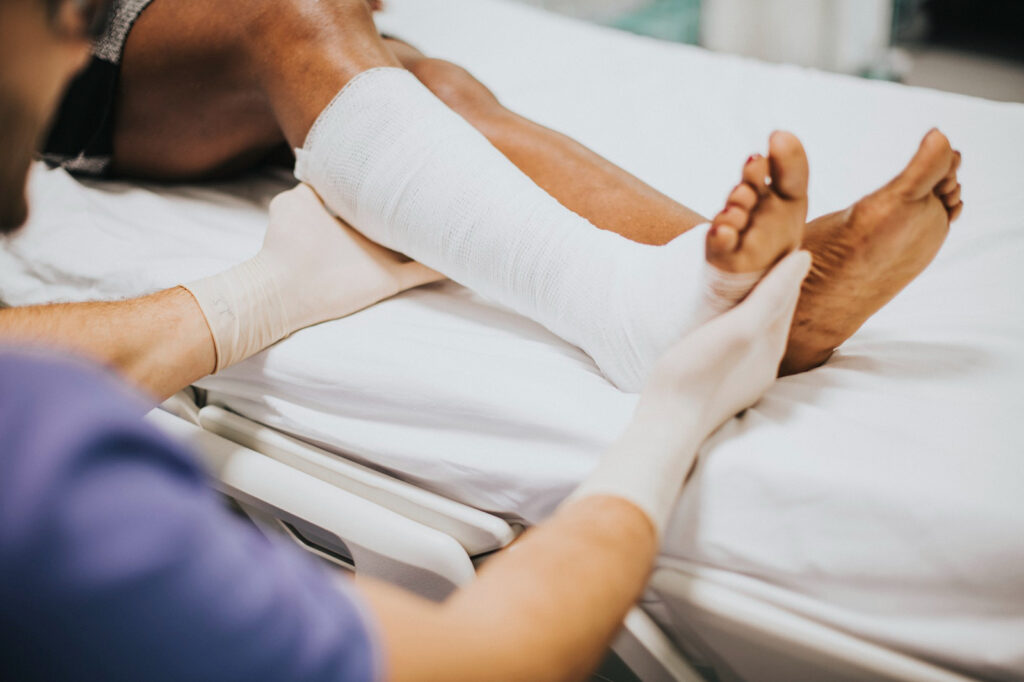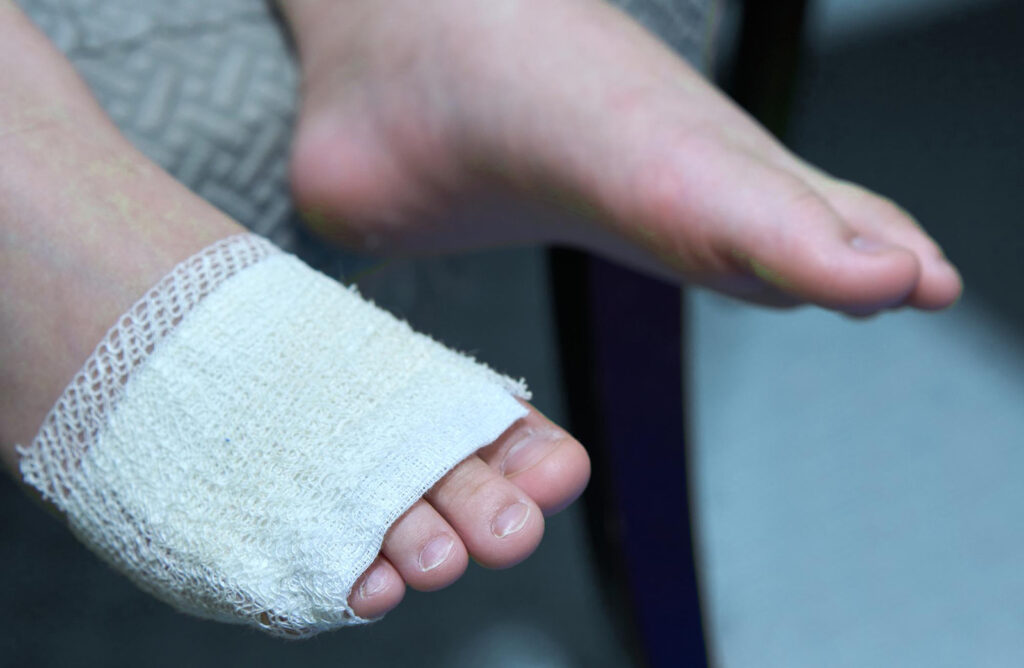Experiencing a diabetic foot ulcer in Los Angeles can be a concerning situation, but timely and specialized care is key to assuring a positive outcome. Immediate intervention by healthcare experts is crucial in effectively managing these ulcers and preventing complications.
Addressing diabetes and neuropathy issues promptly can significantly improve the healing process and overall recovery. Personalized treatment plans focusing on proper wound care and infection prevention are essential for minimizing complications and promoting healing.
If you suspect a foot ulcer, seeking urgent medical attention is important for better results. Specialized care in LA plays a vital role in preventing severe complications and potential amputations, ultimately leading to a smoother recovery journey for diabetic patients.

Understanding Diabetic Foot Ulcers
Diabetic foot ulcers are common complications of diabetes caused by neuropathy and poor circulation. These ulcers require prompt treatment by a specialist to prevent infections, complications, and potential amputations.
Proper foot care, early intervention, and personalized treatment plans are essential for effective management. It’s crucial to recognize the hallmark characteristics and clinical implications of diabetic foot ulcers to address them promptly and prevent further complications.
Symptoms of Diabetic Foot Ulcers
Recognizing diabetic foot ulcers’ symptoms is vital for timely intervention and effective management, especially for diabetic patients. Symptoms may include drainage, redness, swelling, and odor, with pain often being absent due to neuropathy.
Consulting a physician immediately upon noticing these symptoms is crucial to prevent infections and complications. Timely treatment, including proper wound care and blood glucose control, is essential for the best outcomes.
Risk Factors for Diabetic Foot Ulcers
Early identification of key risk factors is crucial in preventing diabetic foot ulcers. Diabetes, neuropathy, vascular disease, foot deformities, poor circulation, and infection prevention are common risk factors.
To manage these risks, effective off-loading strategies and meticulous wound care are essential. By addressing these factors, the likelihood of diabetic foot ulcers can be significantly reduced, promoting better foot health in individuals with diabetes.
Complications of Untreated Foot Ulcers
Diabetic foot ulcers can lead to serious complications if left untreated. These ulcers may result in infections, nerve damage (neuropathy), and, in severe cases, the need for amputation.
Prompt diagnosis, treatment, and preventive measures are vital in managing diabetic foot ulcers to avoid these critical outcomes. If you suspect you have a diabetic foot ulcer, seek immediate medical attention to prevent further complications.
Diabetic Foot Ulcer Treatment Options
Managing diabetic foot ulcers involves specialized care and personalized intervention plans to promote healing and prevent complications.
Dermatologists, like Dr. Ben Behnam, are key in this treatment, focusing on wound care, infection prevention, and specialized foot care.
Here are some treatment options:
- Wound Debridement: Removal of dead or infected tissue to promote wound healing.
- Topical Wound Care:
- Antimicrobial dressings: for controlling infection.
- Moist wound healing: promoting a moist environment to facilitate healing.
- Growth factors: such as recombinant human platelet-derived growth factor (PDGF) to stimulate tissue repair.
- Negative pressure wound therapy (NPWT): applying sub-atmospheric pressure to the wound to promote healing.
- Offloading Devices: Redistribution of pressure away from the ulcerated area using:
- Total contact casts (TCC).
- Orthopedic shoes.
- Custom-made shoe inserts or orthotics.
- Control of Infection:
- Antibiotic therapy: systemic or topical antibiotics may be prescribed based on the severity of infection.
- Wound cultures: to identify the causative organisms and guide antibiotic therapy.
- Glycemic Control:
- Tight control of blood glucose levels through medications, diet, and lifestyle modifications.
- Vascular Assessment and Management:
- Evaluation of blood flow to the affected area.
- Angioplasty or bypass surgery may be necessary to improve blood flow if vascular insufficiency is present.
- Patient Education and Self-care:
- Educating patients on proper foot care, including daily inspection, proper footwear, and avoiding injury.
- Smoking cessation: if applicable, as smoking impairs wound healing and exacerbates vascular problems.
- Hyperbaric Oxygen Therapy (HBOT): In some cases, HBOT may be used to deliver high concentrations of oxygen to the wound site to promote healing.
- Biological Therapies: Emerging treatments such as growth factors, stem cell therapy, and tissue engineering techniques are being investigated for diabetic foot ulcers.
- Multidisciplinary Care: Involvement of a multidisciplinary team including podiatrists, wound care specialists, endocrinologists, vascular surgeons, and infectious disease specialists to optimize treatment outcomes.
Addressing diabetic neuropathy and tailoring wound care are vital to avoid further issues.
With effective diabetic ulcer treatment, complications can be minimized, and healing can be facilitated.
Diabetic Foot Ulcer Diagnosis in Los Angeles
Diagnosing diabetic foot ulcers in Los Angeles involves a thorough evaluation by a specialized healthcare provider. Symptoms like skin discoloration, redness, warmth, and open wounds indicate ulcer development. Accurate diagnosis relies on medical records review, physical exams, and imaging tests such as X-rays.
Prompt specialized care is vital to prevent complications and tailor effective treatment plans for diabetic foot ulcers.
Top Doctor for Diabetic Foot Care in LA
When it comes to managing diabetic foot issues in Los Angeles, choosing an experienced specialist is crucial for effective treatment.
Dr. Ben Behnam is a Board Certified Dermatologist and wound care specialist who also treats non-healing wounds and offers personalized care plans for diabetic foot ulcers. His vast experience in preventing, treating, and managing ulcers assures comprehensive foot care for diabetic patients, promoting healing and reducing risks.
Wound Care for Diabetic Foot Ulcers
Diabetic foot ulcers require specialized wound care to promote healing and prevent complications.
This care includes infection prevention, off-loading pressure from the affected area, debridement of dead tissue, and precise blood glucose management.
Consulting an expert and guidance is crucial in facilitating the healing process and confirming optimal outcomes for individuals with diabetes.

Cost of Diabetic Foot Ulcer Treatment in LA
The cost of diabetic foot ulcer treatment in Los Angeles varies based on your personalized treatment plan. Wound care specialists and podiatrists in LA offer tailored options to prevent complications, infections, and promote healing.
Early intervention is crucial for effective treatment, potentially reducing the need for hospitalization or surgery. Proper prevention strategies also help manage the costs associated with diabetic foot ulcer treatment.
Limb Salvage for Advanced Diabetic Foot Ulcers
Advanced diabetic foot ulcers necessitate specialized limb salvage techniques to preserve the affected limb, prevent amputations, and promote healing. Key strategies include infection prevention, off-loading, debridement, and blood glucose management.
Comprehensive management involves antibiotics, circulation assessment, and tailored treatment plans. These approaches are crucial for addressing the challenges posed by advanced diabetic foot ulcers and improving patient outcomes.
Choosing the Right Diabetic Footwear
When choosing diabetic footwear, focus on comfort, support, and protective features to maintain foot health and prevent complications. Well-fitting shoes can reduce pressure points and friction, helping to prevent diabetic foot ulcers. Consult a podiatrist for guidance on suitable footwear to minimize ulcer risks.
Opt for shoes with ample cushioning and toe room to promote overall foot health.
Home Care for Diabetic Foot Ulcers
Managing diabetic foot ulcers at home requires daily wound care and strict adherence to treatment regimens. Proper care involves meticulous wound cleaning, preventing infections by relieving pressure, regular removal of dead tissue, and monitoring blood sugar levels.
Regularly check circulation to promote healing and avoid complications. Following these steps can lead to effective treatment and better outcomes.
Diabetic Foot Ulcer Emergency Care in LA
Diabetic foot ulcers demand immediate attention in Los Angeles to prevent serious complications. Swift action and specialized medical care are essential for diabetic patients facing foot wounds.
Seeking urgent treatment can prevent infections and the need for amputations. Healthcare professionals must intervene promptly to improve outcomes and increase the healing process.
Early care is crucial to address issues related to diabetes and neuropathy, assuring a smoother recovery for patients.
Contact Dr. Ben for fast diabetic wound ulcer care in Los Angeles.
Advances in Wound Care Technology
Skin substitutes composed of human amniotic membrane have been shown to stimulate wound healing. Sometimes, ulcers remain open for months or years. Non-healing wounds are associated with serious medical consequences such as infection, sepsis, limb amputation, social isolation, depression, and decreased mobility and productivity. Traditionally, patient’s own skin graft were used to stimulate healing. But now there is a new technology that allows for much more efficient and better wound healing.
Allografts are sheets of bioengineered skin grown from donor cells that help promote wound healing. There are many different versions of them. One version of these skin substitutes is called Cygnus, a dual-layered, dehydrated human amniotic membrane. In other words, human amniotic tissue is folded upon one another and dehydrated and placed into the wound. The amniotic tissue contains growth factors that help stimulate wounds to heal.
Dr. Behnam uses the most advanced technology for wound care. In his opinion, the allografts can do miracles for patients with wounds that don’t heal. Allografts skin substitutes are covered by most medicare plans. Usually a prior authorization is performed. “Allogrfats heal wounds faster than traditionally expected, helping patients to get mobile again. I’m proud to be part of that journey!”
Frequently Asked Questions
Can Diabetic Foot Ulcers Be Prevented Through Lifestyle Changes?
To prevent diabetic foot ulcers, focus on lifestyle changes. It’s essential to prioritize proper foot care, daily inspections, and wearing well-fitted shoes. Consulting with a healthcare provider for personalized advice can greatly help. Early intervention plays a crucial role in maintaining foot health and reducing the risk of complications associated with diabetes.
Are There Any Alternative Treatment Options Available for Diabetic Foot Ulcers?
For diabetic foot ulcers, alternative treatments like hyperbaric oxygen therapy and bioengineered skin substitutes can be effective options. Consulting with a specialist, such as Dr. Ben Behnam, can provide personalized recommendations to improve healing and reduce complications. These treatments, when tailored to individual needs, can play a crucial role in improving outcomes for diabetic foot ulcers.
Bioengineered skin substitutes have gained a lot of popularity recently because of their healing potential, especially in diabetic wound ulcers. Dr. Ben Behnam specializes in using bioengineered skin substitutes for non-healing, wounds, such as diabetic wound ulcers.
How Often Should Diabetic Patients Undergo Screenings for Foot Ulcers?
Regular screenings for foot ulcers are crucial for diabetic patients. These screenings should ideally be incorporated into your annual exams to catch any issues early on. It is essential to work closely with your wound care specialists to determine the frequency of these screenings based on your individual health requirements. By staying proactive and vigilant with your foot care, you can significantly reduce the risk of complications associated with diabetes.
Is There a Support Group or Community for Individuals Dealing With Diabetic Foot Ulcers in Los Angeles?
If you are dealing with diabetic foot ulcers in Los Angeles, consider seeking support from local diabetic organizations, clinics, or online communities. These resources can offer valuable insights, emotional support, and shared experiences to help you guide this challenging condition more effectively. Connecting with others who understand what you are going through can provide a sense of comfort and empowerment as you manage your diabetic foot ulcers. Remember, you are not alone in this journey, and reaching out for support can make a significant difference in your overall well-being.
What Role Does Nutrition Play in the Healing Process of Diabetic Foot Ulcers?
Nutrition plays a vital role in the healing process of diabetic foot ulcers. A well-rounded diet containing adequate protein, vitamins, and minerals is essential for promoting faster healing. It is recommended to seek guidance from a healthcare professional to receive personalized dietary recommendations tailored to individual needs. By prioritizing proper nutrition, individuals can support their body’s healing mechanisms and improve the overall healing process of diabetic foot ulcers.
